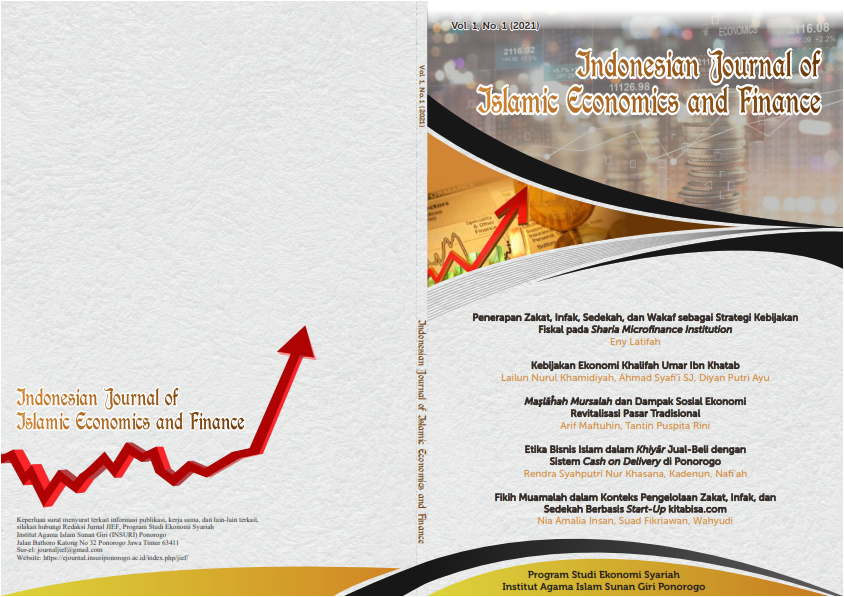Analysis of 5C+1S Principles in Minimizing the Risk of Working Capital Murabahah Financing
DOI:
https://doi.org/10.37680/ijief.v4i2.5792Keywords:
5C 1S Principles; Risk; MurabahahAbstract
This study aims to analyze the application of the 5C+1S (Character, Capacity, Capital, Collateral, Condition, and Sharia) principles in minimizing the risk of Murabahah financing at Bank Syariah Indonesia KCP Pancor. The research uses a qualitative descriptive approach with primary data through employee and customer interviews and secondary data from bank documents. The results show that the 5C+1S principle helps assess customer eligibility despite obstacles such as limited human resources, lack of selectivity in customer selection, and the influence of economic conditions. To overcome these challenges, intensive training is recommended to improve the quality of human resources, periodic supervision of customers, risk analysis technology, diversification of financing portfolios, and improvement of customer financial literacy. Consistent and adaptive implementation of economic changes can help BSI KCP Pancor mitigate the risk of non-performing financing and maintain the sustainability of its operations.
References
Ahmed, A. U., Abdullah, M. N., & Hasan, A. (2021). Human resource management and credit risk in Islamic banks: A case study of Malaysia. Journal of Islamic Finance, 10(2), 85–98.
Ahmed, H., & Ariff, M. (2012). Capital Structure and Islamic Financial Institutions. Journal of Financial Economics, 105(3), 505–520.
Bashir, A., & Ali, M. (2017). Risk management in Islamic banking: A theoretical framework. Journal of Islamic Finance, 6(1), 47–63.
Bley, M. (2019). Managing credit risk in Islamic financial institutions. Journal of Banking and Finance, 43(3), 115–128.
Bogdan, R. C., & Biklen, S. K. (2007). Qualitative research for education: An introduction to theories and methods (5th ed.). Pearson Educati.
Campbell, R., Hossain, T., & Mohammed, A. (2014). Financial Risk Management in Islamic Banking: The Case of Murabaha Financing. Journal of Islamic Finance, 5(1), 32–41.
Cohen, M., & Young, S. (2012). The Role of Character in Lending and Credit Risk. Journal of Banking and Finance, 36(6), 1402–1415.
Creswell, J. W., & Poth, C. N. (2018). Qualitative inquiry and research design: Choosing among five approaches (4th ed.). SAGE Publications.
Denzin, N. K., & Lincoln, Y. S. (2011). The SAGE handbook of qualitative research (4th ed.). SAGE Publications.
El-Gamal, M. A. (2006). Islamic Finance: Law, Economics, and Practice. Cambridge University Press.
Haron, S., Ahmad, N., & Yaacob, M. (2015). The Role of Character in Islamic Banking Credit Risk Management. International Journal of Economics Management, and Accounting, 23(2), 89–104.
Hasan, Z. (2019a). Islamic Banking and Finance: Principles and Practices. Journal of Islamic Economics, 11(2), 25–60.
Hasan, Z. (2019b). Metodologi penelitian kualitatif: Konsep dan aplikasi dalam penelitian sosial (1st ed.). Alfabeta.
Iqbal, M., & Molyneux, P. (2017). Islamic banking and finance: Theory and practice. Palgrave Macmillan.
Jaffar, M. & Awan, H. M. (2018). Capital Structure and Bank Financing: A Case of Pakistan. International Journal of Economics and Finance, 10(5), 115–128.
Jensen, M. C., & Meckling, W. H. (1976). Theory of the Firm: Managerial Behavior, Agency Costs and Ownership Structure. Journal of Financial Economics, 3(4), 305–360.
Kahf, M. (2004). Islamic Banking: A New Approach to Business. Islamic Economic Studies, 11(1), 2–22.
Karim, A. (2017a). Prinsip-prinsip ekonomi syariah: Teori dan praktik di Indonesia (2nd ed.). Kencana.
Karim, A. (2017b). Risk Management in Islamic Banking. Islamic Finance Review, 9(4), 12–25.
Khan, S. A., Ali, M., & Noor, F. (2019). Impact of market competition on credit risk in Islamic banks. International Journal of Islamic and Middle Eastern Finance and Management, 12(4), 322–335.
Kindleberger, C. P., & Aliber, R. Z. (2011). Manias, Panics, and Crashes: A History of Financial Crises. Palgrave Macmillan.
Kotler, P., & Keller, K. L. (n.d.). Marketing Management (15th ed.). In 2016. Pearson.
Lincoln, Y. S., & Guba, E. G. (1985). Naturalistic inquiry. SAGE Publications.
Marty, J. & Wheeler, K. J. of F. S. (2013). Credit Risk Management: Character and Reputation in Lending. Journal of Financial Services, 45(2), 230–245.
Merton, R. C. & Bodie, Z. (1995). A Conceptual Framework for Analyzing the Financial Environment. Journal of Financial Services Research, 9(2), 189–210.
Miles, M. B., & Huberman, A. M. (1994). Qualitative Data Analysis: An Expanded Sourcebook. SAGE Publications.
Minsky, H. P. (1992). The Financial Instability Hypothesis. Journal of Economic Issues, 26(2), 387–393.
Modigliani, F., & Miller, M. H. (1958). The Cost of Capital, Corporation Finance, and the Theory of Investment. American Economic Review, 48(3), 261–297.
Mollah, M. A., Ahmed, N., & Hassan, R. (2020). Credit risk management and performance in Islamic banks: A comparative analysis. International Journal of Islamic Banking and Finance, 8(2), 120–134.
Mollah, M. A., Rahman, M. A., & Ali, S. (2019). Evaluating the impact of human resources on risk management in Islamic banks. Journal of Islamic Economics, Banking, and Finance, 15(1), 41–58.
Mustapha, M. (8 C.E.). Improving the human resource capacity in Islamic banks. International Journal of Islamic Banking and Finance, 1(67–81).
Porter, M. E. (1985). Competitive Advantage: Creating and Sustaining Superior Performance. Free Press.
Rahman, A. (2018a). Manajemen risiko pembiayaan syariah: Perspektif dan praktik dalam menghadapi tantangan ekonomi (1st ed.). UPP STIM YKPN.
Rahman, A. (2018b). Non-Performing Loans in Islamic Banking: Causes and Solutions. Journal of Islamic Banking. Journal of Islamic Banking and Finance, 10(3), 67–80.
Rizvi, S. A. R., & Ullah, M. (2016). Selectivity in Islamic bank lending: A case study of Pakistan. Journal of Islamic Finance, 7(1), 32–43.
Safira, A. M. (2022). Implementasi prinsip character, capacity, capital, collateral, condition of economy (5C) dan syariah (1S) pada pembiayaan murabahah di BPRS Bumi Rinjani Kepanjen pada masa pandemi covid-19. Maulana Malik Ibrahim State Islamic University.
Siagian, D. dan S. (2006). Metode Statistika untuk Bisnis dan Ekonomi. Gramedia Pustaka Utama.
Silverman, D. (2016). Qualitative research (4th ed.). SAGE Publications.
Stiglitz, J. E. & Weiss, A. (1981). Credit Rationing in Markets with Imperfect Information. American Economic Review, 71(3), 393–410.
Sugiono. (2009). Statistika untuk penelitian. Alfabeta.
Sugiyono. (2006). Metode Penelitian Bisnis. Alfabeta.
Sugiyono. (2017). Metode Penelitian Kuantitatif, Kualitatif, dan R&D. Alfabeta.
Tariq, S., & Akhtar, W. (2018). Economic conditions and their impact on risk management in Islamic banks. Journal of Islamic Finance and Business Research, 9(3), 125–138.
Usman, A. (2020). Murabahah Financing in Islamic Banking: A Review. International Journal of Islamic Finance, 12(1), 23–35.
Zulkhibri, M. (2012). Managing Credit Risk in Islamic Banks: The Role of Character and Reputation. Journal of Islamic Banking and Finance, 30(2), 63–77.
Downloads
Published
How to Cite
Issue
Section
License
Copyright:
An author who publishes in Indonesian Journal of Islamic Ekonomics and Finance agrees to the following terms:
- Author retains the copyright and grants the journal the right of first publication of the work simultaneously licensed under a Creative Commons Attribution-NonCommercial 4.0 International License that allows others to share the work with an acknowledgment of the work's authorship and initial publication in this journal.
- Author is able to enter into separate, additional contractual arrangements for the non-exclusive distribution of the journal's published version of the work (e.g., post it to an institutional repository or publish it in a book) with the acknowledgment of its initial publication in this journal.
- Author is permitted and encouraged to post his/her work online (e.g., in institutional repositories or on their website) prior to and during the submission process, as it can lead to productive exchanges, as well as earlier and greater citation of the published work (See The Effect of Open Access).
License:
-
Attribution — You must give appropriate credit, provide a link to the license, and indicate if changes were made. You may do so in any reasonable manner, but not in any way that suggests the licensor endorses you or your use.
-
NonCommercial — You may not use the material for commercial purposes.
-
No additional restrictions — You may not apply legal terms or technological measures that legally restrict others from doing anything the license permits.
You are free to:
- Share — copy and redistribute the material in any medium or format
- Adapt — remix, transform, and build upon the material

This work is licensed under a Creative Commons Attribution-NonCommercial 4.0 International License.



.png)







